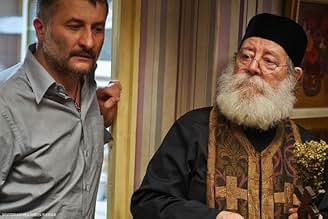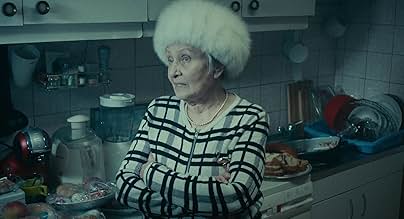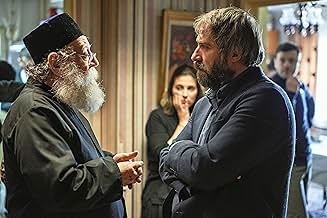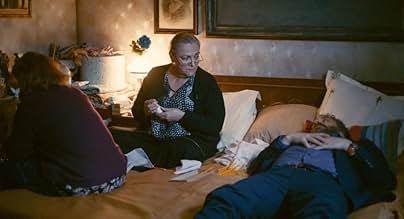Sieranevada
- 2016
- 2 घं 53 मि
IMDb रेटिंग
7.3/10
6 हज़ार
आपकी रेटिंग
अपनी भाषा में प्लॉट जोड़ेंCenters around a family gathering on the anniversary of a patriarch's recent death.Centers around a family gathering on the anniversary of a patriarch's recent death.Centers around a family gathering on the anniversary of a patriarch's recent death.
- पुरस्कार
- 21 जीत और कुल 21 नामांकन
फ़ीचर्ड समीक्षाएं
I don't know why but I found this movie really good. It resembled to the the high school book I had to read in my time, Enigma Otiliei or like Morometii book & screen play.
Like all Romanian movies, it has that drama-parody of being a post-communist member; like all the good post-revolution movies. This movie is from the same category. But! And there's a huge "But". This movie has a really tangled and well-structured story line. The characters are really complex. I loved the "detailed" small-talks that took place alongside the main story. Also, like many Romanian families, you have that huge abundance of relatives that you have to deal with. You have that "It's family!" saying that your mother told you every time you couldn't stand your cousin when you were little. Also, all the actors seem to play their parts really well. I've seen almost all the good Romanian movies and I can say that these are some hardcore actors. They fit so well with their characters and their performance is almost perfect.
Yes, it has the downsides that all Romanian movies have: the static scenes and the bad sound quality. You have to have subtitle otherwise, most of the time, if you are Romanian, you won't understand a word.
All of this being said, enjoy! It's just a pure South-Eastern Week-end story event!
Family drama has never portrayed this good. You are invited into this family's house during the aftermath of a funeral in the wintertime. It gets very intense.
Wow, wow, wow, did I say wow? Wow!
How can three hours of movie go so fast? the movie in itself is very local, but so human, so for people acquainted with the old ways in the Eastern Europe region, this is very evocative.
Everyone, will find a character to like, and one to despise, one too similar to him, and one so dissimilar, that it hurts. Unfortunately I'm a national, and can't figure if the translations make it right, but for sure the dialogue, looks like a stage of 12 Angry Men (this time more like 15), exposing the back bone of a life time at the Paradise's gates.
Sure there are quite a few good movies on the theme, but not many filmed 90% in 500 square feet. So the feeling of being there is so real.
Unfortunately if the first hour eats your interest, I can understand how other people got bored, where I got so excited. Thought the reality of characters is very crisp, almost to the point I can say - that is uncle A, that's Grandpa', and that's Aunt M.
So if you want to get your head spinning, to feel momentary hate for some characters otherwise benign at other points, and wanting to get real exposure to end-of-Communism Romanian urban life. This is it!
How can three hours of movie go so fast? the movie in itself is very local, but so human, so for people acquainted with the old ways in the Eastern Europe region, this is very evocative.
Everyone, will find a character to like, and one to despise, one too similar to him, and one so dissimilar, that it hurts. Unfortunately I'm a national, and can't figure if the translations make it right, but for sure the dialogue, looks like a stage of 12 Angry Men (this time more like 15), exposing the back bone of a life time at the Paradise's gates.
Sure there are quite a few good movies on the theme, but not many filmed 90% in 500 square feet. So the feeling of being there is so real.
Unfortunately if the first hour eats your interest, I can understand how other people got bored, where I got so excited. Thought the reality of characters is very crisp, almost to the point I can say - that is uncle A, that's Grandpa', and that's Aunt M.
So if you want to get your head spinning, to feel momentary hate for some characters otherwise benign at other points, and wanting to get real exposure to end-of-Communism Romanian urban life. This is it!
With a delay of three years I managed to see Cristi Puiu's 'Sieranevada', a film that I had read and heard much about. Three years are certainly not enough for a 'historical' perspective but they are enough to better place the film in the context of what happened in the Romanian cinema before and after it and to understand the rather heated disputes it has created among critics and viewers. The film is indeed complex but also complicated, interesting but also long, providing many reasons to like it but also a few that can leave viewers from different categories of audience confused or dissatisfied.
The opening scene looks like a quote from the other new wave, the French one. A camera set up at a fixed point shoots for a few minutes a Bucharest intersection, with the chaos, agglomeration and noise that we know. The characters of the film, which we do not distinguish, are still silhouettes among the many that make up this hubbub. We'll follow two of them in a car that drives them for several minutes to the apartment where most of the action of the film is taking place. There they join the family reunited for the commemoration meal (following a regional traditional custom!) of the head of the family, who had died 40 days ago. For two hours, almost in real time, we will witness the ceremony, discussions, conflicts of a family large enough to include some of the characters known to those living in Romania today - the physician who abandoned his job for a more profitable trade , a young supporter of conspiracy theories, the older generation of those economically affected by the transition who try to adapt with little success to the new realities, a nostalgic for the communist regime, the young woman with dubious connections and habits including suspected drug use, the priest who is late due to a busy schedule because the religious business is going full on, couples in crisis or marriages already broken up. A beautifully constructed mosaic, a diverse and tormented world. And yet, they will also meet at future occasions or holidays, because family and friendship ties, together with adherence to a religious tradition that is not forgotten or abandoned, are the only links that somehow hold together the Romanian social fabric. These and maybe also the humor.
It is worth watching how Cristi Puiu and his cinematographer Barbu Balasoiu work with the camera. Sometimes the frame is fixed, most often mobile, it follows the point of view of one character or another, giving the feeling of a claustrophobic maze in the 3 or 4 room apartment where the action takes place. It is a sensation programmatically induced to the spectators, when we are outside the apartment we are dealing with the same chaos, with the same maze of human relations in crisis, only that the spaces are more open, but the atmosphere is frozen. The semi-darkness predominates and makes the film not easy to watch, also the sound capture is not optimal, but I think that the reason does not lie in technical issues but in the decisions of the director. Acting is superb, mentioning any name will do an injustice to all the other. The film captivated me and I did not feel or resempt the length at any time. But I can understand those who did not like the duration, or had difficulties in tracking the image or voices, because Cristi Puiu did not aim the aesthetics but wanted to convey ideas and sensations. Foreign viewers will have difficulties understanding many nuances, and those in Romania who are tired or exasperated by the mirrors that some of the contemporary directors put in front of them also have reasons to be upset. As much as I liked the movie, I believe that the minimalist formula has exhausted its resources and has certainly lost the elements of surprise and novelty. That's why I'm not surprised that the movie was ignored in the Cannes palmares. In 2005, Cristi Puiu made one of the first remarkable films of the new wave of Romanian cinema - 'The Death of Mr. Lazarescu'. 'Sieranevada' made in 2016 may be one of the last outstanding films of this wave.
The opening scene looks like a quote from the other new wave, the French one. A camera set up at a fixed point shoots for a few minutes a Bucharest intersection, with the chaos, agglomeration and noise that we know. The characters of the film, which we do not distinguish, are still silhouettes among the many that make up this hubbub. We'll follow two of them in a car that drives them for several minutes to the apartment where most of the action of the film is taking place. There they join the family reunited for the commemoration meal (following a regional traditional custom!) of the head of the family, who had died 40 days ago. For two hours, almost in real time, we will witness the ceremony, discussions, conflicts of a family large enough to include some of the characters known to those living in Romania today - the physician who abandoned his job for a more profitable trade , a young supporter of conspiracy theories, the older generation of those economically affected by the transition who try to adapt with little success to the new realities, a nostalgic for the communist regime, the young woman with dubious connections and habits including suspected drug use, the priest who is late due to a busy schedule because the religious business is going full on, couples in crisis or marriages already broken up. A beautifully constructed mosaic, a diverse and tormented world. And yet, they will also meet at future occasions or holidays, because family and friendship ties, together with adherence to a religious tradition that is not forgotten or abandoned, are the only links that somehow hold together the Romanian social fabric. These and maybe also the humor.
It is worth watching how Cristi Puiu and his cinematographer Barbu Balasoiu work with the camera. Sometimes the frame is fixed, most often mobile, it follows the point of view of one character or another, giving the feeling of a claustrophobic maze in the 3 or 4 room apartment where the action takes place. It is a sensation programmatically induced to the spectators, when we are outside the apartment we are dealing with the same chaos, with the same maze of human relations in crisis, only that the spaces are more open, but the atmosphere is frozen. The semi-darkness predominates and makes the film not easy to watch, also the sound capture is not optimal, but I think that the reason does not lie in technical issues but in the decisions of the director. Acting is superb, mentioning any name will do an injustice to all the other. The film captivated me and I did not feel or resempt the length at any time. But I can understand those who did not like the duration, or had difficulties in tracking the image or voices, because Cristi Puiu did not aim the aesthetics but wanted to convey ideas and sensations. Foreign viewers will have difficulties understanding many nuances, and those in Romania who are tired or exasperated by the mirrors that some of the contemporary directors put in front of them also have reasons to be upset. As much as I liked the movie, I believe that the minimalist formula has exhausted its resources and has certainly lost the elements of surprise and novelty. That's why I'm not surprised that the movie was ignored in the Cannes palmares. In 2005, Cristi Puiu made one of the first remarkable films of the new wave of Romanian cinema - 'The Death of Mr. Lazarescu'. 'Sieranevada' made in 2016 may be one of the last outstanding films of this wave.
The long demanding exhausting movie is permeated with Eastern European scent. The legacy of the poor relatives and backyards of Europe is recognisable in every excruciating detail for those who had grown up there. Smallish crowded kitchens with dilapidated cabinets. Worn out light switches which were the same in Bucharest or Kyiv. Long tables if unfolded occupy the whole living room and you squeeze yourself out to get to your seat. Low-waged doctors who downshift to medical equipment salesmen. And the family saga which unfolds painfully slow and mesmerisingly absorbing. Once you are on the other side of the film equator you cannot but start guessing what the hell is going on in this family. Cutting of the movie is so unorthodox that you start wondering if there had been any cutting at all.
क्या आपको पता है
- ट्रिवियाThe title, deliberately misspelled, is a parody of esoteric film titles and does not refer to anything specific.
- क्रेज़ी क्रेडिटSilvia Nastase is credited in the opening titles but not in the end credits.
- कनेक्शनReferences स्नो व्हाइट ऐंड द सेवन ड्वार्फ्स (1937)
- साउंडट्रैकSymphony in C minor J-C 9, I. Allegro
Composed by Giovanni Battista Sammartini
Performed by Aradia Ensemble
Conducted by Kevin Mallon
Courtesy of Naxos Deutschland GmbH
टॉप पसंद
रेटिंग देने के लिए साइन-इन करें और वैयक्तिकृत सुझावों के लिए वॉचलिस्ट करें
- How long is Sieranevada?Alexa द्वारा संचालित
विवरण
- रिलीज़ की तारीख़
- कंट्री ऑफ़ ओरिजिन
- आधिकारिक साइट
- भाषा
- इस रूप में भी जाना जाता है
- Сьєраневада
- फ़िल्माने की जगहें
- Strada Ionel Perlea, बुखारेस्ट, रोमानिया(Opening scene: Lary's street)
- उत्पादन कंपनियां
- IMDbPro पर और कंपनी क्रेडिट देखें
बॉक्स ऑफ़िस
- बजट
- €14,00,000(अनुमानित)
- दुनिया भर में सकल
- $2,47,196
- चलने की अवधि
- 2 घं 53 मि(173 min)
- रंग
- पक्ष अनुपात
- 1.85 : 1
इस पेज में योगदान दें
किसी बदलाव का सुझाव दें या अनुपलब्ध कॉन्टेंट जोड़ें


























